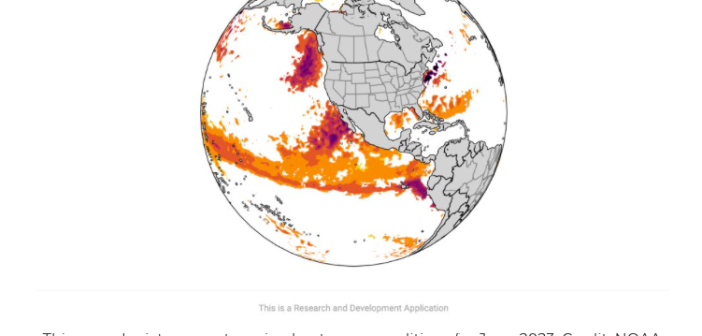Half the oceans of the world may register heatwaves by September, according to a new NOAA forecast. Here’s the NOAA report:
As scientists around the world sound the alarm about record sea surface temperatures, a new experimental NOAA forecast system predicts that half of the global oceans may experience marine heatwave conditions by the end of summer.
The surface temperatures of about 40% of the global oceans are already high enough to meet the criteria for a marine heatwave — a period of persistent anomalously warm ocean temperatures — which can have significant impacts on marine life as well as coastal communities and economies. The new forecast by the Physical Sciences Laboratory (PSL) projects that it will increase to 50% by September, and it could stay that way through the end of the year.
“No doubt, we’re in hot water,” said Dillon Amaya, a PSL research scientist and a co-lead of NOAA’s June 2023 marine heatwave experimental outlook. “In our 32-year record, we have never seen such widespread marine heatwave conditions.”
Observations show marine heatwaves are occurring across vast regions of the planet, including: the tropical North Atlantic, the Northeast Atlantic along the Iberian coast as far northward as Ireland and the UK, the equatorial Pacific, the Northeast Pacific, the Northwest Pacific in the Sea of Japan, the Southwest Pacific just southeast of New Zealand and the Western Indian Ocean southeast of Madagascar.
“Normally we might expect only about 10% of the world’s oceans to be ‘hot enough’ to be considered a marine heatwave, so it’s remarkable to reach 40% or 50%, even with long-term warming,” Amaya said.
PSL scientists say there’s high confidence that the marine heatwave in the equatorial Pacific, where El Niño conditions are measured, will persist and intensify through the end of the year. The experimental PSL forecast also projects with medium confidence that marine heatwave conditions may develop beginning in spring 2024 along the U.S. Pacific Northwest coast, the region where the infamous three-year “Blob” extreme heat event devastated fisheries and disrupted marine populations.
The experimental forecast, which tracks the NOAA Climate Prediction Center’s official outlook, is based on a large ensemble of climate model predictions spanning June 2023 through May 2024. Read more:
https://research.noaa.gov/2023/06/28/global-ocean-roiled-by-marine-heatwaves-with-more-on-the-way/




